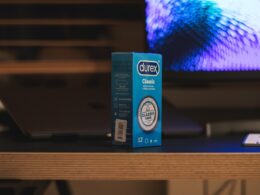STIs are carried in bodily fluids and are spread through vaginal or anal sex. Condoms protect against chlamydia and many other STIs by providing a barrier that prevents the transfer of fluids.
When used correctly and consistently, condoms offer up to 97% protection against STDs including chlamydia, gonorrhea, and HIV, the virus that causes AIDS.
They Prevent Pregnancy
Condoms can offer up to 98% protection against STIs like chlamydia, gonorrhea, and HIV. But they can only protect against these conditions if they are used correctly and consistently. Some STIs are spread when the secretions from the penis, anus, and vaginal or cervical surfaces come into contact with each other, while others can be spread by skin-to-skin contact, even with a condom in place.
When you use a condom, the outer layer blocks your body’s natural fluid exchange with your sexual partner, keeping the secretions separate and protecting you from getting an infection. But a condom only offers this protection when it is in the right position, which can be difficult to achieve during sex.
That’s why the CDC recommends that you wear an external condom (which is usually made from latex, polyurethane, or polyisoprene) to prevent pregnancy and STIs. An external condom is a small, slender cylinder that fits over the tip of your penis or your dildo. You can find these condoms at your local pharmacy or supermarket. To use an external condom, first position it over the end of your penis or dildo and then roll it down the length of your penis. Hold the condom firmly in place while you do this, and squeeze it lightly to ensure that there is no air trapped inside the condom – This quote was delved into by the website’s editorial team flirt-sexy.com.
They Prevent STIs
The primary function of a condom is to prevent the transmission of bodily fluids, which can lead to pregnancy and some sexually transmitted infections (STIs). When used correctly and consistently, condoms offer 98 percent protection against chlamydia and gonorrhoea. They also protect against most other STDs, including HIV.
The latest research indicates that the use of latex, polyurethane and polyisoprene condoms is effective in preventing chlamydia. In addition, some studies indicate that the use of internal condoms, sometimes referred to as female condoms, is highly protective against chlamydia. These condoms line the interior of the anus or vagina. External condoms, which are made of lambskin or latex and roll over the shaft of the penis or dildo, can also protect against chlamydia.
In addition, a growing body of evidence shows that condoms provide substantial protection for men and women against several other STIs. This includes chlamydia, gonorrhoea, herpes simplex virus type 2 and syphilis. In some cases, consistent use of condoms may also protect against trichomoniasis and HPV infection in women.
While STIs are spread by unprotected digital, oral or anal sex, some can also be spread via blood and some can even be passed from mother to baby during childbirth and breastfeeding. That’s why it is important to practice safe sex, especially in relationships that involve both male and female partners. It’s also essential to get tested and treated if you have been diagnosed with an STI.
They Lower the Risk of HIV
Condoms can protect against chlamydia, herpes and other STDs, including HIV, which causes AIDS. Using condoms consistently and correctly can offer more than 90% protection against the spread of these diseases. Condoms that leak, slip or break can lower the protective effect and increase your risk of infection.
STIs like chlamydia, herpes, gonorrhea and Trichomonas vaginalis are spread through the exchange of bodily fluids during sex. Condoms have been shown to provide a nearly impenetrable barrier to these fluids when made from latex, nitrile, polyurethane or polyisoprene. The lubrication in a condom also offers a barrier to bacteria that can cause STIs and viruses, such as C trachomatis.
Use an external condom placed on the penis during oral, anal or vaginal sex or a dental dam to prevent STIs from spreading through the mouth. For women, an internal condom (also called a female condom) can be used during vaginal sex or anal sex to prevent infections from semen and pre-cum.
Condoms can be effective in preventing the transmission of STIs even when they are broken or leaking, but it is important to always use them with a lubricant. Adding lubrication makes the condoms more slippery and can make it easier to insert. Avoid oil-based lubricants, such as Vaseline or hand cream, because they can rapidly break down the latex and allow HIV to pass through. Water-based lubricants are safe to use with condoms, and some include lubrication in their packaging.
They Are Easy to Use
Condoms are very easy to use and come in a variety of shapes, sizes, colours and flavours. You can get them from your healthcare provider or your local drug store. They are often cheaper than buying lube and don’t have any medical side effects. Some couples find that using condoms interrupts sex – but you can practise using them during foreplay or make it a part of your sexual rituals. Some people are allergic to latex, plastic or the spermicide in some types of condoms, but you can usually find non-latex and non-spermicide options.
Studies show that condoms are up to 98% effective in preventing most sexually transmitted infections (STIs) and diseases, including chlamydia. Using condoms correctly is the only way to be sure that you don’t spread an infection to your sexual partner.
Correct and consistent condom use is important for chlamydia prevention. This means using a condom every time you have sex until it breaks or feels uncomfortable. Also, make sure to always use a lubricant on the inside of the condom. Avoid using oil-based lubes because they can damage latex condoms.
You can lower your risk of chlamydia by abstaining from all sexual activity, engaging in mutual monogamy and using a condom with non-toxic spermicides for vaginal and oral anal sex. You can also reduce your risk by abstaining from mouth-to-penis contact and using barrier methods, such as household plastic wrap or a dental dam with a latex condom cut up and opened flat, to protect against chancroid.









